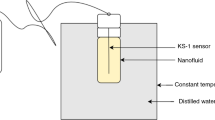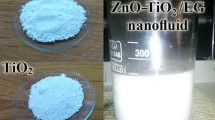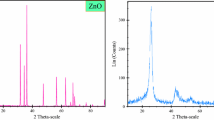Abstract
The work focuses on an experimental evaluation of the changes of thermal conductivity (TC) of ethylene glycol-based nanofluid containing SiO2 nanoadditives against volume concentration of nanoadditives (φ) and temperature. The experiments are carried out in the φ range of 0–2.5% and temperature range of 30–55 °C. The dynamic light scattering method is used to obtain the particle size distribution, while the transmission electron microscopy technique is utilized to visualize agglomerated particles in the prepared nanofluid samples. The outcomes revealed that the TC of the nanofluid grows by boosting both the φ and temperature. The percentage enhancement varied in the range of 0.72–26.66%. Furthermore, the curve-fitting method was utilized to model the TC of the nanofluid using experimental data. It was found that the developed model is able to properly forecast the TC of nanofluid with the maximum percentage error of 1.75%.










Similar content being viewed by others
References
Mesgarpour M, Heydari A, Saddodin S. Investigating the effect of connection type of a sintered porous fin through a channel on heat transfer and fluid flow. J Therm Anal Calorim. 2019;135:461–74.
Adam AY, Oumer AN, Ishak M, Firdaus M, Aklilu TB. State of the art on flow and heat transfer performance of compact fin-and-tube heat exchangers. J Therm Anal Calorim. 2020;139:2739–68.
Al-Rashed AAAA, Shahsavar A, Entezari S, Moghimi MA, Adio SA, Nguyen TK. Numerical investigation of non-Newtonian water–CMC/CuO nanofluid flow in an offset strip-fin microchannel heat sink: thermal performance and thermodynamic considerations. Appl Therm Eng. 2019;155:247–58.
Sheikholeslami M, Jafaryar M, Hedayat M, Shafee A, Li Z, Nguyen TK, Bakouri M. Heat transfer and turbulent simulation of nanomaterial due to compound turbulator including irreversibility analysis. Int J Heat Mass Trans. 2019;137:1290–300.
Nikoozadeh A, Behzadmehr A, Payan S. Numerical investigation of turbulent heat transfer enhancement using combined propeller-type turbulator and nanofluid in a circular tube. J Therm Anal Calorim. 2020;140:1044.
Sheikholeslami M, Jafaryar M, Shafee A, Li Z, Haq RU. Heat transfer of nanoparticles employing innovative turbulator considering entropy generation. Int J Heat Mass Transf. 2019;136:1233–40.
Shahsavar A, Shaham A, Talebizadehsardari P. Wavy channels triple-tube LHS unit with sinusoidal variable wavelength in charging/discharging mechanism. Int Commun Heat Mass Transf. 2019;107:93–105.
Al-Rashed AAAA, Shahsavar A, Rasooli O, Moghimi MA, Karimipour A, Tran MD. Numerical assessment into the hydrothermal and entropy generation characteristics of biological water–silver nano-fluid in a wavy walled microchannel heat sink. Int Commun Heat Mass Transf. 2019;104:118–26.
Shahsavar A, Al-Rashed AAAA, Entezari S, Talebizadehsardari P. Melting and solidification characteristics of a double-pipe latent heat storage system with sinusoidal wavy channels embedded in a porous medium. Energy. 2019;171:751–69.
Alnaqi AA, Aghakhani S, Pordanjani AH, Bakhtiari R, Asadi A, Tran MD. Effects of magnetic field on the convective heat transfer rate and entropy generation of a nanofluid in an inclined square cavity equipped with a conductor fin: considering the radiation effect. Int J Heat Mass Transf. 2019;133:256–67.
Talebizadehsardari P, Shahsavar A, Toghraie D, Barnoon P. An experimental investigation for study the rheological behavior of water–carbon nanotube/magnetite nanofluid subjected to a magnetic field. Phys A. 2019;534:122129.
Alsarraf J, Rahmani R, Shahsavar A, Afrand M, Wongwises S. Effect of magnetic field on laminar forced convective heat transfer of MWCNT–Fe3O4/water hybrid nanofluid in a heated tube. J Therm Anal Calorim. 2019;137:1809–25.
Parvin S, Chamkha AJ. An analysis on free convection flow, heat transfer and entropy generation in an odd-shaped cavity filled with nanofluid. Int Commun Heat Mass Transf. 2014;54:8–17.
Reddy PS, Chamkha AJ. Soret and Dufour effects on MHD convective flow of Al2O3–water and TiO2–water nanofluids past a stretching sheet in porous media with heat generation/absorption. Adv Powder Technol. 2016;27:1207–18.
Dogonchi AS, Armaghani T, Chamkha AJ, Ganji DD. Natural convection analysis in a cavity with an inclined elliptical heater subject to shape factor of nanoparticles and magnetic field. J Therm Anal Calorim. 2019;44:7919–31.
Dogonchi AS, Nayak MK, Karimi N, Chamkha AJ, Ganji DD. Numerical simulation of hydrothermal features of Cu–H2O nanofluid natural convection within a porous annulus considering diverse configurations of heater. J Therm Anal Calorim. 2020. https://doi.org/10.1007/s10973-020-09419-y.
Dogonchi AS, Tayebi T, Chamkha AJ, Ganji DD. Natural convection analysis in a square enclosure with a wavy circular heater under magnetic field and nanoparticles. J Therm Anal Calorim. 2020. https://doi.org/10.1007/s10973-020-09419-y.
Alsabery AI, Armaghani T, Chamkha AJ, Hashim I. Two-phase nanofluid model and magnetic field effects on mixed convection in a lid-driven cavity containing heated triangular wall. Alex Eng J. 2020;59:129–48.
Choi SUS. Enhancing thermal conductivity of fluids with nanoparticles. ASME FED. 1995;231:99–105.
Shahsavar A, Baseri MH, Al-Rashed AAAA, Afrand M. Numerical investigation of forced convection heat transfer and flow irreversibility in a novel heatsink with helical microchannels working with biologically synthesized water-silver nano-fluid. Int Commun Heat Mass Transf. 2019;108:104324.
Liu WI, Al-Rashed AAAA, Alsagri AS, Mahmoudi B, Shahsavar A, Afrand M. Laminar forced convection performance of non-Newtonian water–CNT/Fe3O4 nano-fluid inside a minichannel hairpin heat exchanger: effect of inlet temperature. Powder Technol. 2019;354:247–58.
Al-Rashed AAAA, Shahsavar A, Akbari M, Toghraie D, Akbari M, Afrand M. Finite volume simulation of mixed convection in an inclined lid-driven cavity filled with nanofluids: effects of a hot elliptical centric cylinder, cavity angle and volume fraction of nanoparticles. Phys A. 2019;527:121122.
Shahsavar A, Bagherzadeh SA, Mahmoudi B, Hajizadeh A, Afrand M, Nguyen TK. Robust weighted least squares support vector regression algorithm to estimate the nanofluid thermal properties of water/graphene oxide–silicon carbide mixture. Phys A. 2019;525:1418–28.
Asadi A, Alarifi IM, Ali V, Nguyen HM. An experimental investigation on the effects of ultrasonication time on stability and thermal conductivity of MWCNT–water nanofluid: finding the optimum ultrasonication time. Ultrason Sonochem. 2019;58:104639.
Hadavand M, Yousefzadeh S, Akbari OA, Pourfattah F, Nguyen HM, Asadi A. A numerical investigation on the effects of mixed convection of Ag–water nanofluid inside a sim-circular lid-driven cavity on the temperature of an electronic silicon chip. Appl Therm Eng. 2019;162:114298.
Shahsavar A, Khanmohammadi S, Toghraie D, Salihepour H. Experimental investigation and develop ANNs by introducing the suitable architectures and training algorithms supported by sensitivity analysis: measure thermal conductivity and viscosity for liquid paraffin based nanofluid containing Al2O3 nanoparticles. J Mol Liq. 2019;276:850–60.
Mehryan SAM, Izadpanahi E, Ghalambaz M, Chamkha AJ. Mixed convection flow caused by an oscillating cylinder in a square cavity filled with Cu–Al2O3/water hybrid nanofluid. J Therm Anal Calorim. 2019;137:965–82.
Ghalambaz M, Doostani A, Izadpanahi E, Chamkha AJ. Conjugate natural convection flow of Ag–MgO/water hybrid nanofluid in a square cavity. J Therm Anal Calorim. 2020;139:2321–36.
Jing D, Song D. Optical properties of nanofluids considering particle size distribution: experimental and theoretical investigations. Renew Sust Energy Rev. 2017;78:452–65.
Walshe J, Amarandei G, Ahmed H, McCormack S, Doran J. Development of poly-vinyl alcohol stabilized silver nanofluids for solar thermal applications. Sol Energy Mater Sol Cells. 2019;201:110085.
Toghraie D, Sina N, Jolfaei NA, Hajian M, Afrand M. Designing an artificial neural network (ANN) to predict the viscosity of silver/ethylene glycol nanofluid at different temperatures and volume fraction of nanoparticles. Phys A. 2019;534:122142.
Abdullah AM, Chowdhury AR, Yang Y, Vasquez H, Moore HJ, Parsons JG, Lozano K, Gutierrez JJ, Martirosyan KS, Uddin MJ. Tailoring the viscosity of water and ethylene glycol based TiO2 nanofluids. J Mol Liq. 2020;297:111982.
Akhgar A, Toghraie D, Sina N, Afrand M. Developing dissimilar artificial neural networks (ANNs) to prediction the thermal conductivity of MWCNT–TiO2/water–ethylene glycol hybrid nanofluid. Powder Technol. 2019;355:602–10.
Hazra SK, Ghosh S, Nandi TK. Photo-thermal conversion characteristics of carbon black-ethylene glycol nanofluids for applications in direct absorption solar collectors. Appl Therm Eng. 2019;163:114402.
Akilu S, Baheta AT, Kadirgama K, Padmanabhan E, Sharma KV. Viscosity, electrical and thermal conductivities of ethylene and propylene glycol-based β-SiC nanofluids. J Mol Liq. 2019;284:780–92.
Samylingam L, Anamalai K, Kadirgama K, Samykano M, Ramasamy D, Noor MM, Najafi G, Rahman MM, Xian HW, Sidik NAC. Thermal analysis of cellulose nanocrystal–ethylene glycol nanofluid coolant. Int J Heat Mass Transf. 2018;127:173–81.
Zyla G. Nanofluids containing low fraction of carbon black nanoparticles in ethylene glycol: an experimental study on their rheological properties. J Mol Liq. 2020;297:111732.
Li L, Zhai Y, Jin Y, Wang J, Wang H, Ma M. Stability, thermal performance and artificial neural network modeling of viscosity and thermal conductivity of Al2O3–ethylene glycol nanofluids. Powder Technol. 2020;363:360–8.
Jang H, Lee WS, Lee J. Rheological characteristics of non-Newtonian GPTMS–SiO2 nanofluids. Int Commun Heat Mass Transf. 2019;106:38–45.
Zakaria IA, Mohamed WANW, Zailan MB, Azmi WH. Experimental analysis of SiO2–distilled water nanofluids in a polymer electrolyte membrane fuel cell parallel channel cooling plate. Int J Hydrog Energy. 2019;44:25850–62.
Etedali S, Afrand M, Abdollahi A. Effect of different surfactants on the pool boiling heat transfer of SiO2/deionized water nanofluid on a copper surface. Int J Therm Sci. 2019;145:105977.
Nithiyanantham U, Zaki A, Grosu Y, Gonzalez-Fernandez L, Igartua JM, Faik A. SiO2@Al2O3 core–shell nanoparticles based molten salts nanofluids for thermal energy storage applications. J Mol Liq. 2019;26:101033.
Hamid KA, Azmi WH, Mamat R, Sharma KV. Heat transfer performance of TiO2–SiO2 nanofluids in a tube with wire coil inserts. Appl Therm Eng. 2019;152:275–86.
Zyla G, Fal J. Viscosity, thermal and electrical conductivity of silicon dioxide–ethylene glycol transparent nanofluids: an experimental studies. Thermochim Acta. 2017;650:106–13.
Guo W, Li G, Zheng Y, Dong C. Measurement of the thermal conductivity of SiO2 nanofluids with an optimized transient hot wire method. Thermochim Acta. 2018;651:84–97.
Das SK, Choi SUS, Yu W, Pradeep T. Nanofluids: science and technology. New York: Wiley; 2007.
A. Handbook. ASHRAE Handbook—Fundamentals. Atlanta: A. Handbook; 2009.
Keblinski P, Phillpot SR, Choi SUS, Eastman JA. Mechanism of heat flow in suspensions of nano-sized particles (nanofluids). Int J Heat Mass Transf. 2002;45:855–63.
Eastman JA, Phillpot SR, Choi SUS, Keblinski P. Thermal transport in nanofluids. Annu Rev Mater Res. 2004;34:219–46.
Chopkar M, Sudarshan S, Das PK, Manna I. Effect of particle size on thermal conductivity of nanofluid. Metall Mater Trans A. 2008;39:1535–42.
Darvanjooghi MHK, Esfahany MN. Experimental investigation of the effect of nanoparticle size on thermal conductivity of in situ prepared silica–ethanol nanofluid. Int Commun Heat Mass Transf. 2016;77:148–54.
Shahsavar A, Salimpour MR, Saghafian M, Shafii MB. Experimental investigation on laminar forced convective heat transfer of ferrofluid loaded with carbon nanotubes under constant and alternating magnetic field. Exp Therm Fluid Sci. 2016;76:1–11.
Shahsavar A, Salimpour MR, Saghafian M, Shafii MB. Effect of magnetic field on thermal conductivity and viscosity of a magnetic nanofluid loaded with carbon nanotubes. J Mech Sci Technol. 2016;30:809–15.
Shahsavar A, Salimpour MR, Saghafian M, Shafii MB. Effect of temperature and concentration on thermal conductivity and viscosity of ferrofluid loaded with carbon nanotubes. Heat Mass Transf. 2016;52:2293–301.
Shahsavar A, Salimpour MR, Saghafian M, Shafii MB. An experimental study on the effect of ultrasonication on thermal conductivity of ferrofluid loaded with carbon nanotubes. Thermochim Acta. 2015;617:102–10.
Maxwell JC. A treatise on electricity and magnetism. Boca Raton: Clarendon Press; 1881.
Lu SY, Lin HC. Effective conductivity of composites containing aligned spheroidal inclusions of finite conductivity. J Appl Phys. 1996;79:6761–9.
Acknowledgements
The work is supported by China Postdoctoral Science Foundation (2018M642181), National Natural Science Foundation of China (Nos. 51679181, U1764262) and the National Key Research and Development Program of China (2017YFB0102603).
Author information
Authors and Affiliations
Corresponding author
Additional information
Publisher's Note
Springer Nature remains neutral with regard to jurisdictional claims in published maps and institutional affiliations.
Rights and permissions
About this article
Cite this article
Li, Y., Shahsavar, A. & Talebizadehsardari, P. Thermal conductivity of ethylene glycol-based nanofluid containing SiO2 nanoadditives: experimental data and modeling through curve fitting. J Therm Anal Calorim 146, 1101–1109 (2021). https://doi.org/10.1007/s10973-020-10098-y
Received:
Accepted:
Published:
Issue Date:
DOI: https://doi.org/10.1007/s10973-020-10098-y




